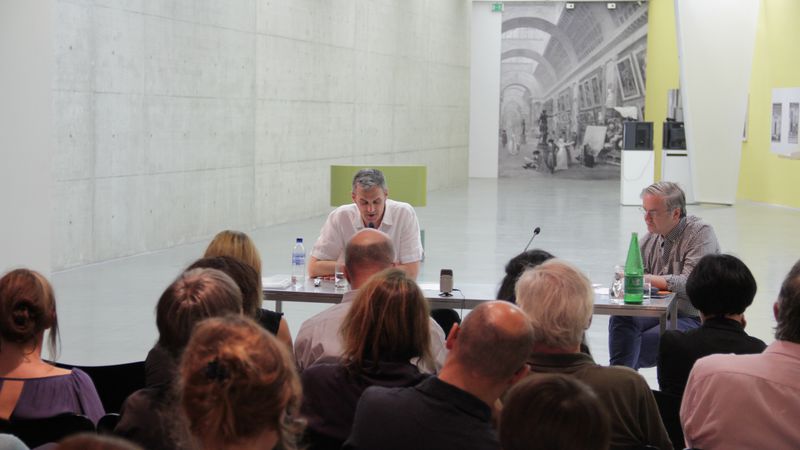The Curatorial. A Philosophy of Curating

Saturday, June 22, 2013, 5–7 p.m. (English)
Lecture by Jean-Paul Martinon, philosopher, followed by a conversation with Helmut Draxler, art historian
This talk will put forward ten theses on the philosophy of curating. These short theses will not comment on the exhibition, nor put forward other examples or attempts to create a chronology of key exhibitions (thus generating an art history of exhibition practices). Instead, they intend to discuss the differences between ‘curating’ and ‘the curatorial’. If ‘curating’ is a gamut of professional practices for setting up exhibitions, then ‘the curatorial’ explores what takes place on the stage set up, both intentionally and unintentionally, by the curator. Ultimately, the aim of these ten theses is to continue Helmut Draxler’s questioning of the activity of curating as exposed in The Content of Form.
Jean-Paul Martinon is Program Leader of the MPhil/PhD Program in Visual Cultures at Goldsmiths College, University of London. He was the co-founder and curator of Rear Window (www.rear-window.org.uk), an independent arts trust that staged a series of exhibitions and conferences in temporary sites across London. His publications include Swelling Grounds, A history of Hackney Workhouse (1729–1929) (London: Rear Window Publications, 1995); On Futurity. Malabou, Nancy, and Derrida (Basingstoke: Palgrave Macmillan, 2007); The End of Man (Brooklyn, NY: Punctum Books, 2013), on the temporal dimension of masculinity; and After “Rwanda” (Amsterdam: Rodopi, 2013), on the concept of peace after the Rwandan genocide. He is also the editor of The Curatorial: A Philosophy of Curating (London: I.B. Tauris, 2013), which includes an essay by Helmut Draxler. www.jeanpaulmartinon.net
On Collecting Critical Art Practices
Hal Foster, art historian and art critic, in conversation with Helmut Draxler, art historian
Against the backdrop of Helmut Draxler’s exhibition, The Content of Form, the topic of this conversation revolves around the following key questions: Are there intrinsically critical art practices? Or have art and critique as different forms of symbolic production gotten together in some specific way in order to infect each other? Do artworks, once infected by critique, remain critical, or do they need a special form of preservation and actualization? What happens with them within the canonizing procedures of art history, of museological classification and preservation, and of representational usage? Is their afterlife making them post-critical?
Hal Foster is an art historian and art critic. He is a professor in the Department of Art and Archaeology at Princeton University. His publications include Art Since 1900 (London: Thames & Hudson, 2005), a co-authored textbook on 20th-century art; Prosthetic Gods (Cambridge, MA: The MIT Press, 2004), about the relation between modernism and psychoanalysis, and Design and Crime (and other diatribes) (London – New York: Verso Books, 2002), on problems in contemporary art, architecture, and design. In 2011, two books were published: The Art-Architecture Complex (London – New York: Verso Books, 2011) and The First Pop Age: Painting and Subjectivity in the Art of Hamilton, Lichtenstein, Warhol, Richter, and Ruscha (Princeton, NJ: Princeton University Press, 2011). Member of the American Academy of Arts and Sciences, Foster continues to write regularly for October (which he co-edits), Artforum, and The London Review of Books.
Helmut Draxler is an art historian and cultural theorist. He was director of the Munich Kunstverein from 1992 to 1995 and professor of aesthetic theory at the Merz Akademie in Stuttgart from 1999 until 2012. Since January 2013, he has been professor of art theory and art education at the Academy of Fine Arts in Nuremberg. His current research foci include a theory of the communication of art and the thinking of history in the historiographies of modern and contemporary art. His publications include Gefährliche Substanzen: Zum Verhältnis von Kritik und Kunst (Berlin: b_books, 2007); Die Gewalt des Zusammenhangs: Raum, Referenz und Repräsentation bei Fareed Armaly (Berlin: b_books, 2007); Film, Avantgarde, Biopolitik, with Sabeth Buchmann and Stephan Geene (Vienna: Schlebrügge Editor, 2009); and Theorien der Passivität, co-edited with Kathrin Busch (Munich: Wilhelm Fink Verlag, forthcoming).
Admission free